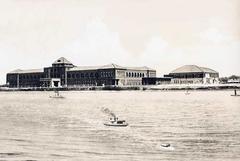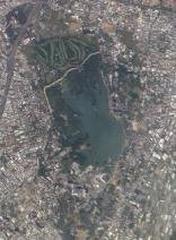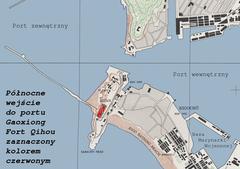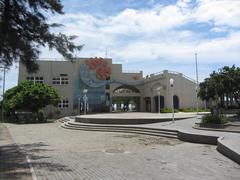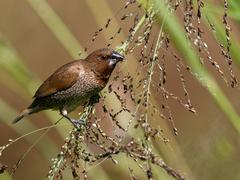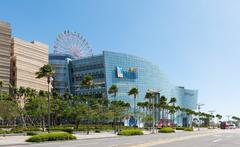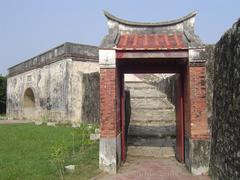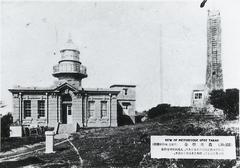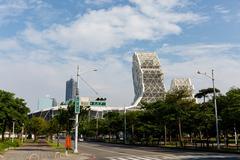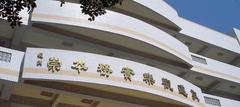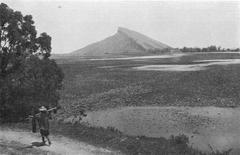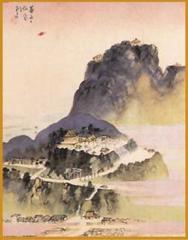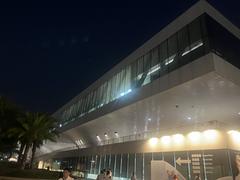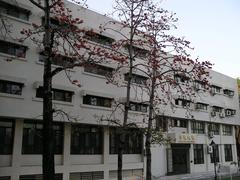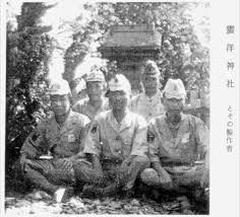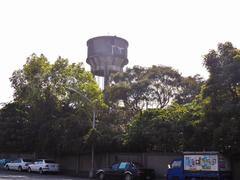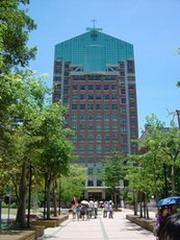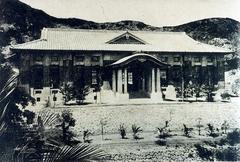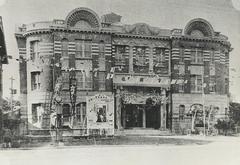National Stadium Kaohsiung: Visiting Hours, Tickets, and Complete Travel Guide
Date: 03/07/2025
Introduction
Kaohsiung National Stadium, a marvel of sustainable architecture and a symbol of cultural pride, stands as a dynamic centerpiece in southern Taiwan. Designed by the acclaimed Japanese architect Toyo Ito, this stadium is not only the largest in Taiwan, with a capacity of 55,000, but also the world’s first entirely solar-powered stadium. Its dragon-inspired, semi-spiral structure integrates 8,844 solar panels, generating over 1.14 GWh of clean energy annually. Since its debut at the 2009 World Games, the stadium has evolved into a premier venue for international sporting events, concerts, festivals, and community gatherings, drawing travelers, sports fans, and design enthusiasts from around the globe.
This guide offers all you need to plan your visit, including key historical insights, visiting hours, ticketing details, accessibility, transport tips, nearby attractions, and practical advice for a memorable experience. For further background, visitor stories, and technical information, see Atlas Obscura, WikiArquitectura, and interpcan.ca.
Contents
- Introduction
- Historical Background
- Architectural and Environmental Innovation
- Visiting Information
- Hours & Admission
- Guided Tours
- Accessibility
- Transportation & Parking
- Photography Tips
- Nearby Attractions
- Major Events & Facilities
- Visitor FAQs
- Practical Tips
- Conclusion
- Sources & Further Reading
Historical Background
Vision and Construction
The idea for Kaohsiung National Stadium arose in the early 2000s, when Kaohsiung was chosen to host the 2009 World Games. The aim was to create a world-class sports facility that would showcase Taiwan’s dedication to innovation, environmental stewardship, and cultural identity (Atlas Obscura). Toyo Ito’s winning design drew inspiration from Taiwanese mythology, most notably the dragon—a symbol of strength and prosperity—reflected in the stadium’s sweeping, semi-spiral form.
Construction began in 2006, costing around $150 million USD. The stadium occupies a 19-hectare site in the Zuoying District, boasting a footprint of 25,553 square meters within a total developed area of nearly 47,000 square meters (WikiArquitectura).
Sustainability and Cultural Impact
Kaohsiung National Stadium is globally recognized for its pioneering sustainability features. The stadium’s 8,844 solar panels provide all its electricity during events and contribute surplus energy to the city grid on non-event days (Architectuul). Rainwater harvesting and ecological landscaping further reduce its environmental impact, supporting local biodiversity and countering urban heat.
The dragon-inspired architecture not only enhances the city’s skyline but also embodies Kaohsiung’s transformation from an industrial port into a vibrant, green innovation hub (IQ Magazine).
Signature Events and Legacy
Since the 2009 World Games, the stadium has hosted everything from international football tournaments and track events to concerts by global superstars like Coldplay, Ed Sheeran, Stray Kids, and Blackpink (Allkpop; IQ Magazine). Its flexible design makes it ideal for a variety of cultural events, music festivals, and community gatherings.
Toyo Ito’s innovative approach earned the stadium international acclaim, including the prestigious Pritzker Architecture Prize (Old Stadium Journey).
Architectural and Environmental Innovation
Distinctive Design
The stadium’s semi-spiral, open-ended form and steel roof evoke the image of a dragon, integrating seamlessly with the adjacent 19-hectare parkland. The design promotes natural ventilation, daylight, and unobstructed sightlines from every seat.
Eco-Friendly Features
- Solar Power: 8,844 photovoltaic panels generate over 1.14 GWh of electricity annually, reducing CO2 emissions by an estimated 660 tons per year (mondoworldwide.com).
- Rainwater Harvesting: Collected rainwater irrigates the grounds and maintains the ecological pond, supporting local flora and fauna (interpcan.ca).
- Recyclable Materials: The stadium’s structure uses 100% recyclable Taiwanese steel and environmentally conscious building materials.
Visiting Information
Hours & Admission
- General Opening: 9:00 AM – 6:00 PM daily. Hours may vary for special events or public holidays.
- Admission: Entry to the stadium grounds is usually free. Tickets are required for events, matches, concerts, and guided tours. Guided tour tickets: NT$150 (adults), with concessions for students and seniors. Event pricing varies—expect NT$300–NT$2,000 for major events (Triphobo).
- How to Buy: Purchase tickets online via official platforms, at stadium box offices, or at convenience stores like 7-Eleven and FamilyMart.
Guided Tours
- Available on weekends and public holidays; advance booking is recommended.
- Tours provide insights into the stadium’s architecture, environmental systems, and operational highlights.
Accessibility
- Fully wheelchair accessible: ramps, elevators, designated seating, accessible restrooms, and parking are available.
- Barrier-free navigation throughout the stadium and surrounding parkland (interpcan.ca).
Transportation & Parking
- MRT: Take the Kaohsiung MRT Red Line to World Games Station (R17); a short walk leads to the stadium (Chris & Wren’s World).
- Bus: Several city bus lines serve the area.
- Taxi/Ride-sharing: Widely available; approximately 15–20 minutes from Kaohsiung Main Station.
- Parking: Limited on-site and underground parking; public transport is strongly recommended, especially on event days.
Photography Tips
- Best spots: Spiral exterior, solar panel roof, upper-tier panoramic views, and the landscaped park.
- Photography is permitted in public areas but may be restricted during certain events.
Facilities & Amenities
- Seating: 55,000 seats with excellent sightlines; VIP and accessible seating available.
- Food & Drink: Local and international food stalls during events; restaurants and cafes nearby in Zuoying District.
- Restrooms: Modern facilities throughout.
- Shops: Souvenir and merchandise outlets.
- First Aid & Info Desks: Located near main entrances.
Major Events & Facilities
Sports
- Hosted the 2009 World Games, FIFA U-20 World Cup, East Asian Football Championship, and more.
- Home ground for the Chinese Taipei National Football Team; regular athletics, rugby, and field sports (WikiArquitectura).
Concerts & Entertainment
- Hosted artists including Bruno Mars, Blackpink, ONE OK ROCK, Coldplay, and Ed Sheeran.
- Renowned for superior acoustics, lighting, and flexible event spaces (Songkick; JamBase).
Community & Cultural Events
- Music festivals, performances, and citywide celebrations such as the Kaohsiung Lantern Festival.
Nearby Attractions
- Lotus Pond: Scenic lake with iconic pagodas and temples.
- Pier-2 Art Center: Contemporary art and creative spaces.
- Liuhe Night Market: Renowned for local street food.
- Kaohsiung Confucius Temple: A tranquil historic site.
- Weiwuying Street Art Village: Urban art and culture hub (Chris & Wren’s World).
Visitor FAQs
What are the stadium’s visiting hours?
Generally 9:00 AM–6:00 PM, but check the official website for event-specific hours.
How do I buy tickets?
Via online platforms, stadium box office, or convenience stores like 7-Eleven and FamilyMart (Triphobo).
Is the stadium wheelchair accessible?
Yes, full barrier-free access including seating, restrooms, and parking.
Are guided tours available?
Yes, weekends and holidays; advance booking is advised.
Can I take photos inside?
Yes, in public areas; restrictions may apply during certain events.
What’s the best way to get there?
MRT Red Line to World Games Station (R17) is the fastest and most eco-friendly.
Practical Tips
- Book Early: Secure event tickets and guided tours in advance.
- Arrive Early: Especially on event days to avoid congestion.
- Weather: Kaohsiung is hot and humid in summer—wear light clothing, use sun protection, and stay hydrated (Taiwan Obsessed).
- Language: English signage is common; staff may speak basic English. Translation apps are helpful.
- Cash/Card: Carry some cash for small purchases.
- Safety: The stadium and city are safe, with clear security protocols and emergency assistance (Chris & Wren’s World).
Conclusion
The Kaohsiung National Stadium is an essential experience for anyone interested in sports, architecture, sustainability, or Taiwanese culture. Its groundbreaking solar-powered infrastructure, lush parkland setting, and vibrant event calendar make it a highlight of any Kaohsiung itinerary. Plan ahead, utilize public transport, and explore the stadium’s many offerings—from guided tours to major international events. For real-time updates, ticketing, and visitor resources, check official platforms and consider downloading the Audiala app for the latest event information and exclusive content.
Further Resources
- Old Stadium Journey
- Interpcan
- Songkick
- JamBase
- Triphobo
- IQ Magazine
- WikiArquitectura
- Atlas Obscura
- Architectuul
- mondoworldwide.com
- Chris & Wren’s World
- Taiwan Obsessed
